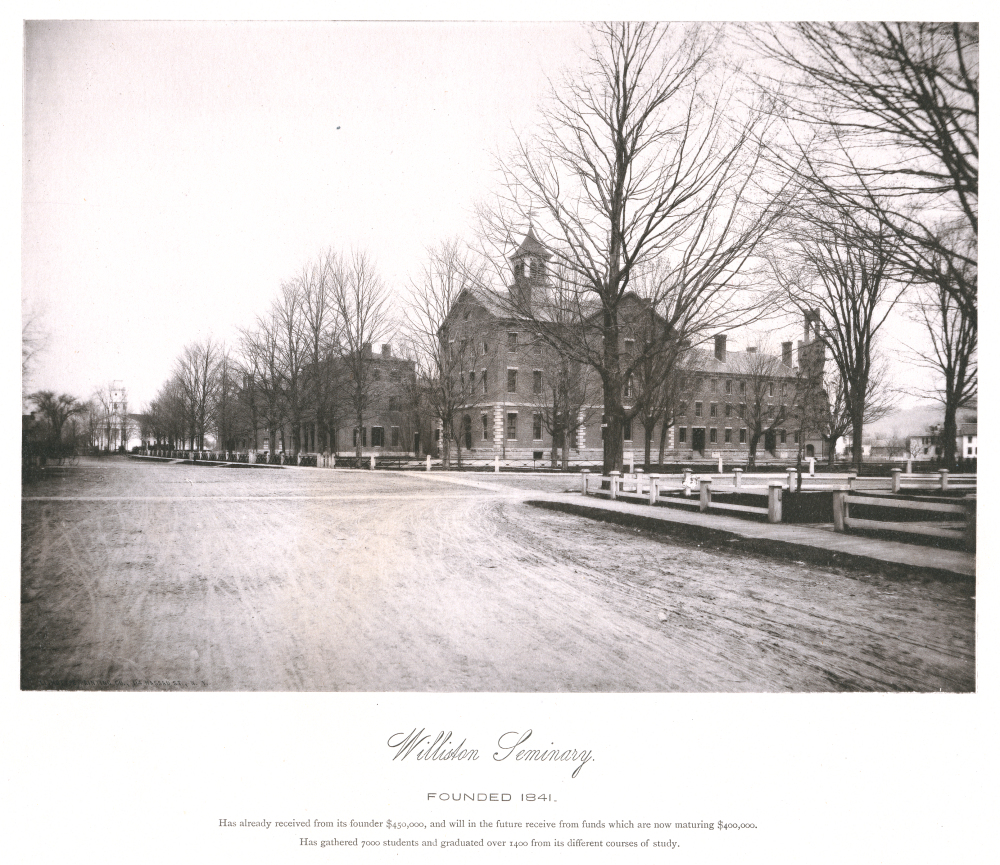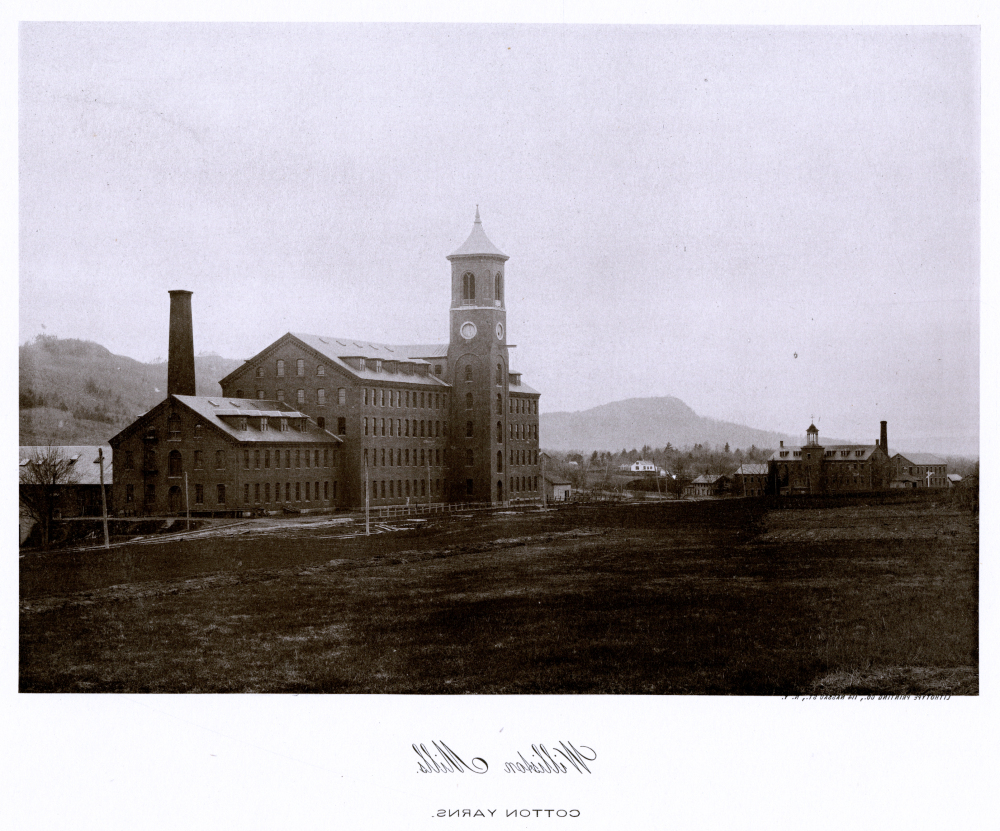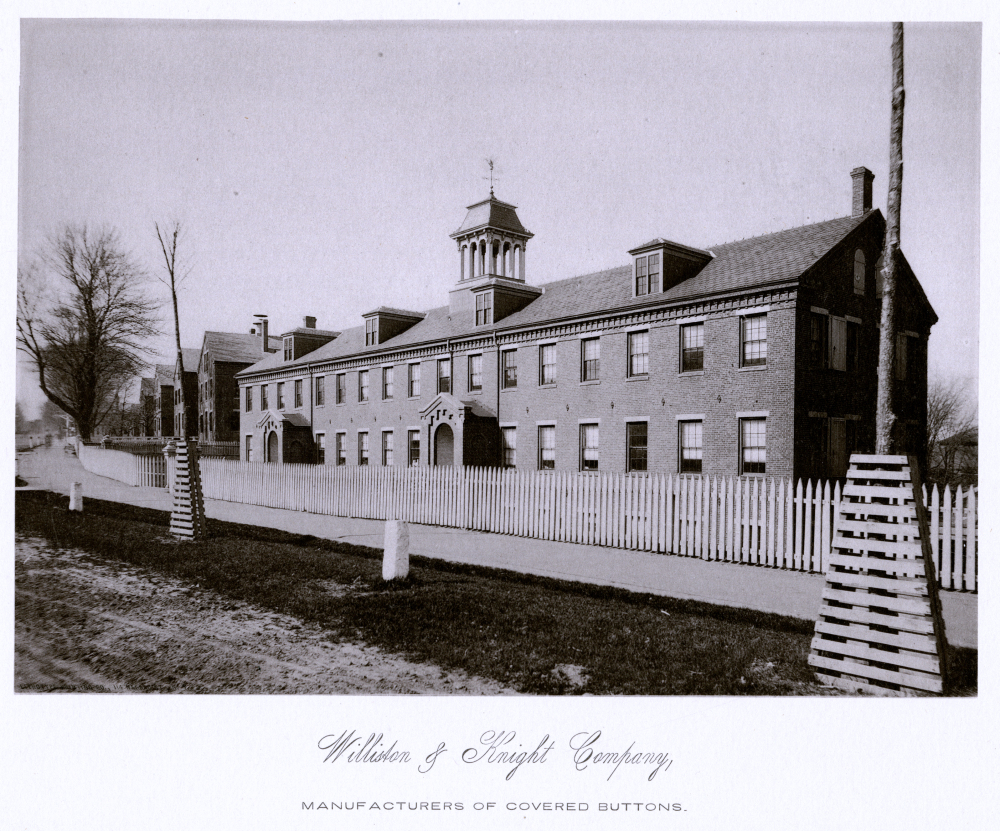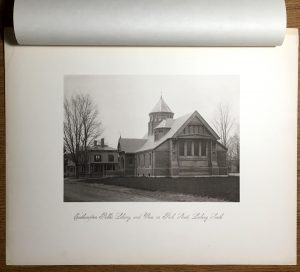
The Archives hold several sets of a portfolio entitled East Hampton Illustrated, containing 32 lithotype photographs of Easthampton. Many are images of Williston Seminary and of buildings associated with Samuel Williston or his business partners; the balance are of other Easthampton landmarks, most of them industrial.
The set was published by the Linotype Printing Co., 114 Nassau St., New York, and is undated. Most antiquarian booksellers date the portfolio ca. 1900, but all of the photographs are older. The catalog of the Sterling and Francine Clark Art Institute Library in Williamstown, MA dates the collection ca. 1880. Information in some of the photo captions, noted below, suggests that the album appeared after 1881 and no later than 1895. Thus, we estimate the publication date as ca. 1890.
No. 1: View of Easthampton from Adams Street, Looking North
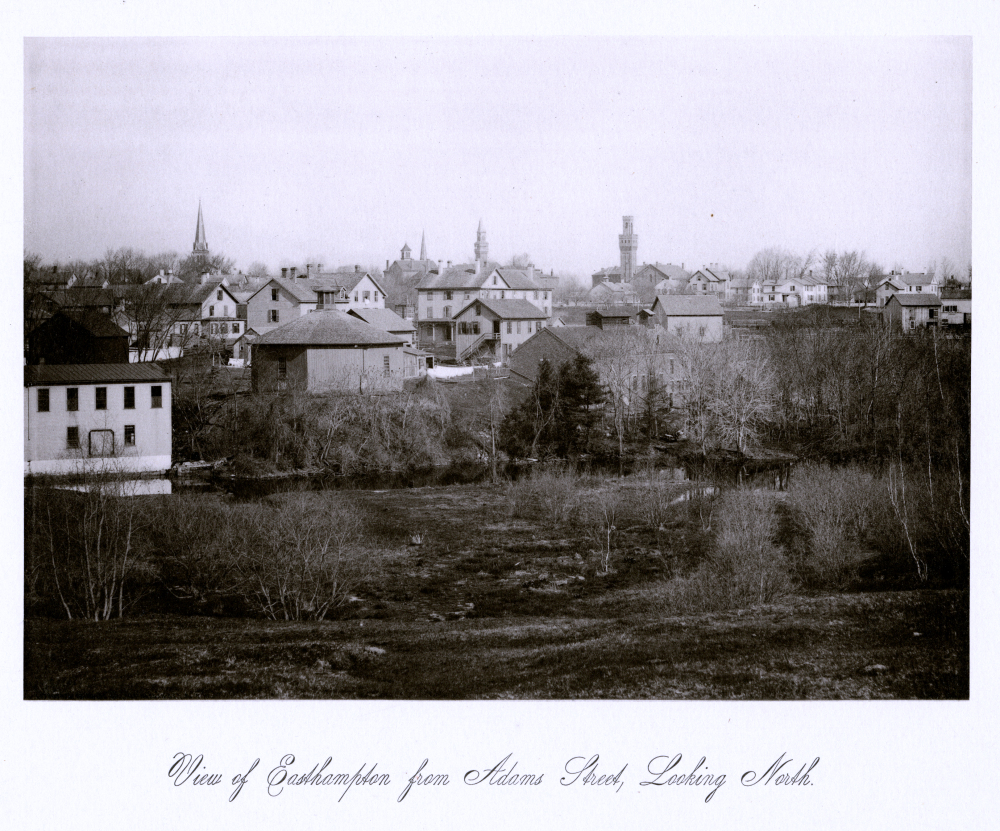 The vantage point is near the intersection of Adams and Liberty Streets, more specifically looking northwest. In the distance are the spires of the Payson (Easthampton Congregational) and Methodist Churches (a different structure than the present day former church housing the Young World Childcare Center), the Town Hall, and the Williston Seminary gymnasium. The reach from the Nashawannuck spillway to the Lower Mill Pond is visible in the foreground. The area today is heavily wooded.
The vantage point is near the intersection of Adams and Liberty Streets, more specifically looking northwest. In the distance are the spires of the Payson (Easthampton Congregational) and Methodist Churches (a different structure than the present day former church housing the Young World Childcare Center), the Town Hall, and the Williston Seminary gymnasium. The reach from the Nashawannuck spillway to the Lower Mill Pond is visible in the foreground. The area today is heavily wooded.
Incidentally, for this article we have, perhaps, broken a rule. The reproduced images have been adjusted to mitigate yellowing and fading, so that their appearance better approaches their original state – which, admittedly, we can only conjecture. As always, you may click on the photographs to enlarge them.
No. 2: Williston Seminary
A view of the original Williston Seminary campus on Main Street. Union Street is to the right; the split rail fence surrounds the Payson Church – the present-day Easthampton Congregational Church. The three main campus buildings, from the foreground back, were, with an appalling lack of creativity, named South, Middle, and North Halls, The gymnasium tower is visible behind South Hall, and one can make out the First Congregational Church (1836; see “The Congregational Church in Easthampton History”) in the distance, at the end of Main Street.
No. 3: General View of Williston Seminary
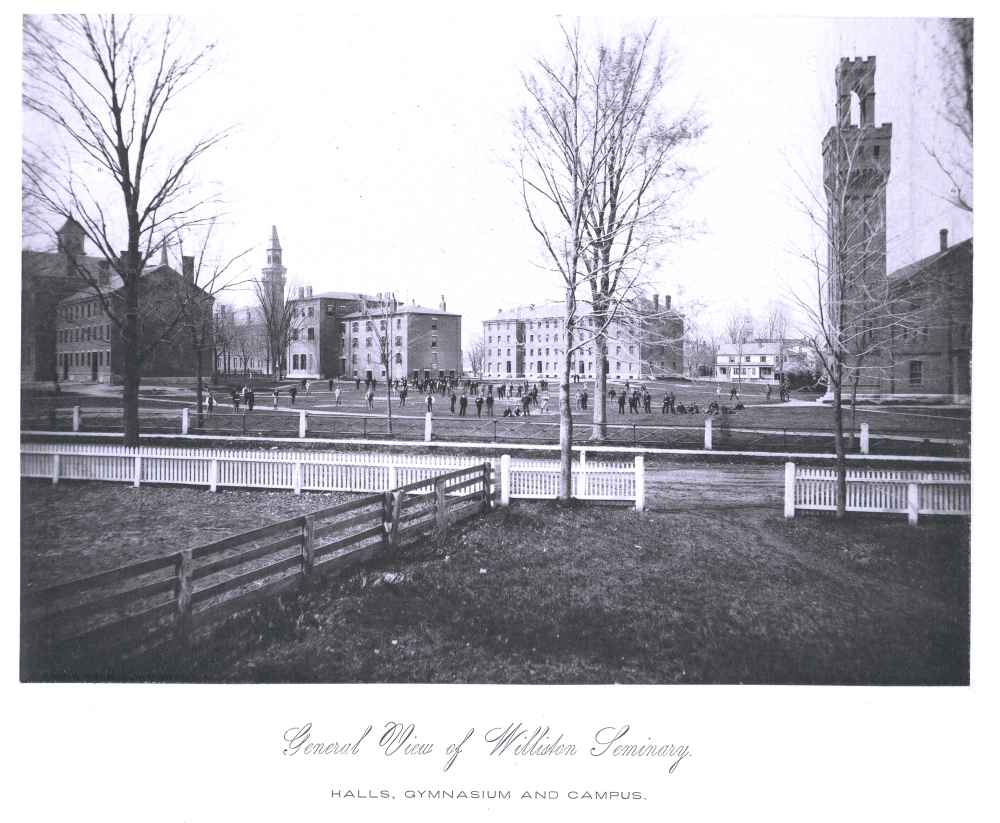 This unusual view from across Union Street, near the side entrance to the Payson Church, shows South, Middle, and North Halls, with the Principal’s House, still standing at the corner of Pleasant Street and recently renovated, in the right distance. (Despite the name, from 1849 forward the Principals resided elsewhere.) The Gymnasium, with its distinctive tower, is at right. Close examination of the photo shows a baseball game in progress.
This unusual view from across Union Street, near the side entrance to the Payson Church, shows South, Middle, and North Halls, with the Principal’s House, still standing at the corner of Pleasant Street and recently renovated, in the right distance. (Despite the name, from 1849 forward the Principals resided elsewhere.) The Gymnasium, with its distinctive tower, is at right. Close examination of the photo shows a baseball game in progress.
North, Middle, and South Halls, and the Gymnasium were demolished in or shortly after 1952, after Williston Academy consolidated operations on the present Park Street/Payson Avenue campus.
No. 4: South Hall
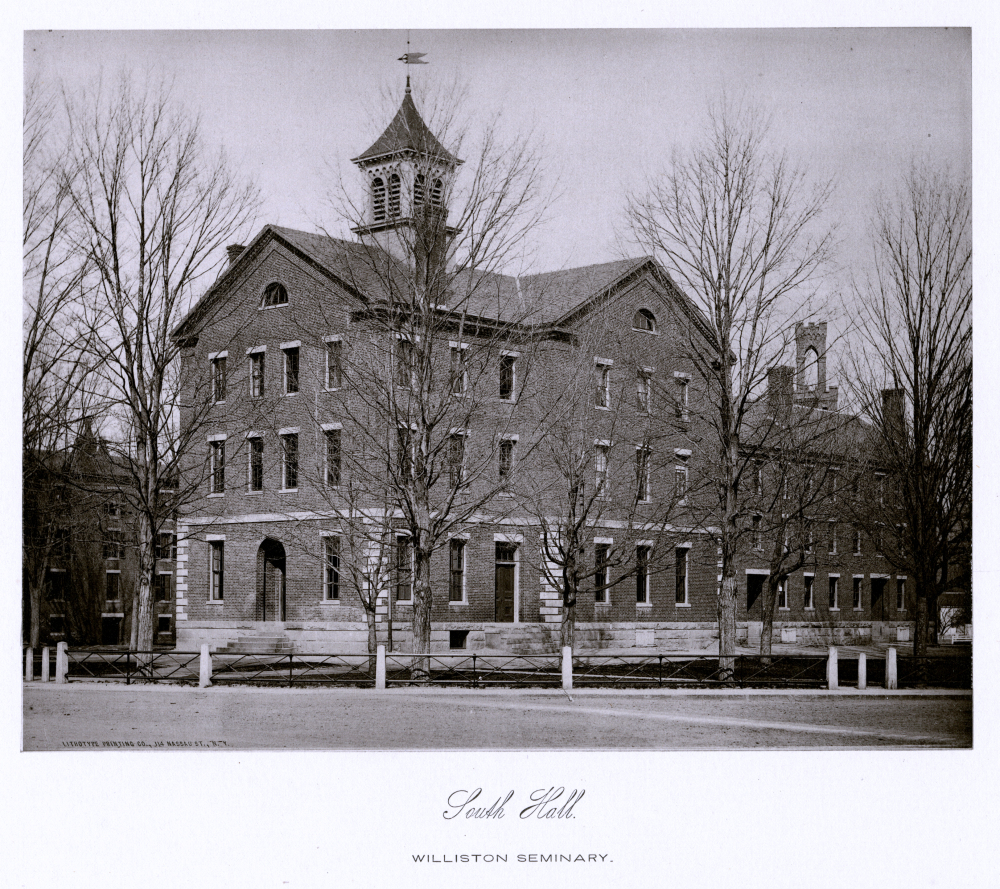 South Hall, sometimes called Chapel Hall, was built in 1857, following a fire that destroyed the original Seminary Building. (See “The Great Seminary Fire” and “Abner Austin, Fireman.”) We view the building from the intersection of Main and Union Streets; Galaxy, Domino’s, and Big E’s Supermarket occupy the space today.
South Hall, sometimes called Chapel Hall, was built in 1857, following a fire that destroyed the original Seminary Building. (See “The Great Seminary Fire” and “Abner Austin, Fireman.”) We view the building from the intersection of Main and Union Streets; Galaxy, Domino’s, and Big E’s Supermarket occupy the space today.
No. 5: Middle Hall
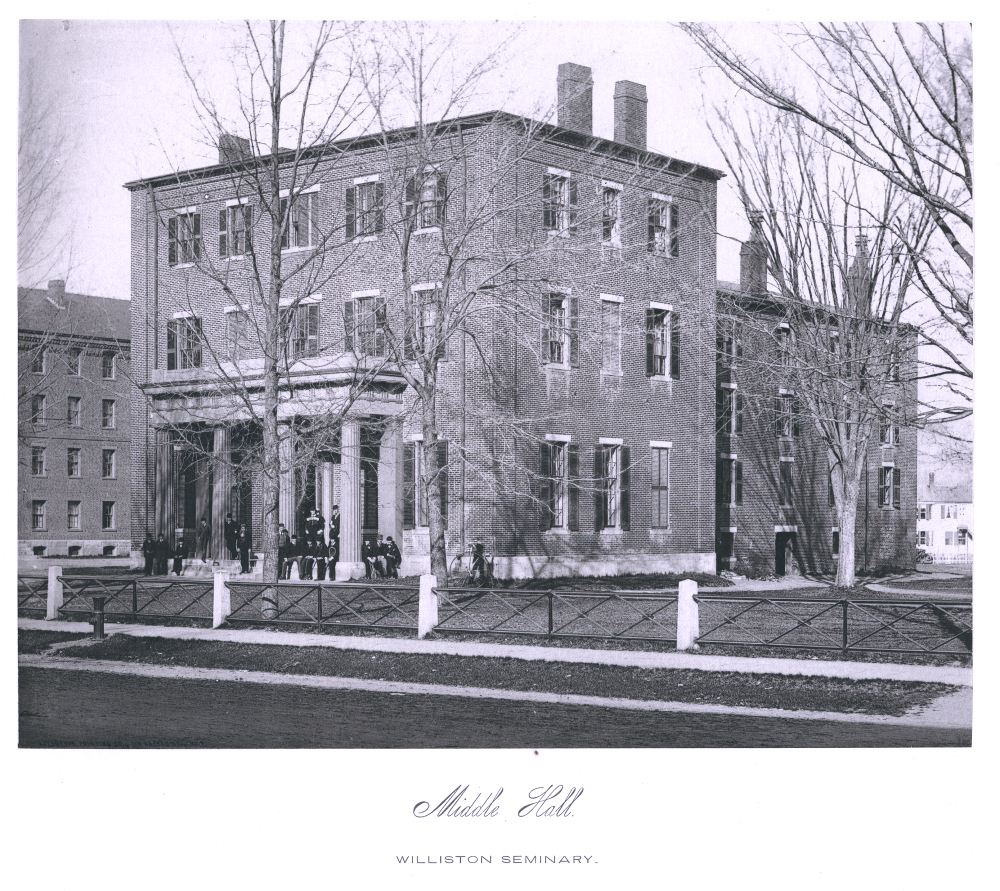 Middle Hall, sometimes call English Hall, was opened in 1844 and remained in use until 1951. At that time, when school operations were transferred entirely to the current campus, the pillared porch was removed and installed on what is now called the Schoolhouse, at 19 Payson Avenue. The former Bank of America branch stands here today, and a portion of the distinctive cast-iron fence remains.
Middle Hall, sometimes call English Hall, was opened in 1844 and remained in use until 1951. At that time, when school operations were transferred entirely to the current campus, the pillared porch was removed and installed on what is now called the Schoolhouse, at 19 Payson Avenue. The former Bank of America branch stands here today, and a portion of the distinctive cast-iron fence remains.
No. 6: North Hall
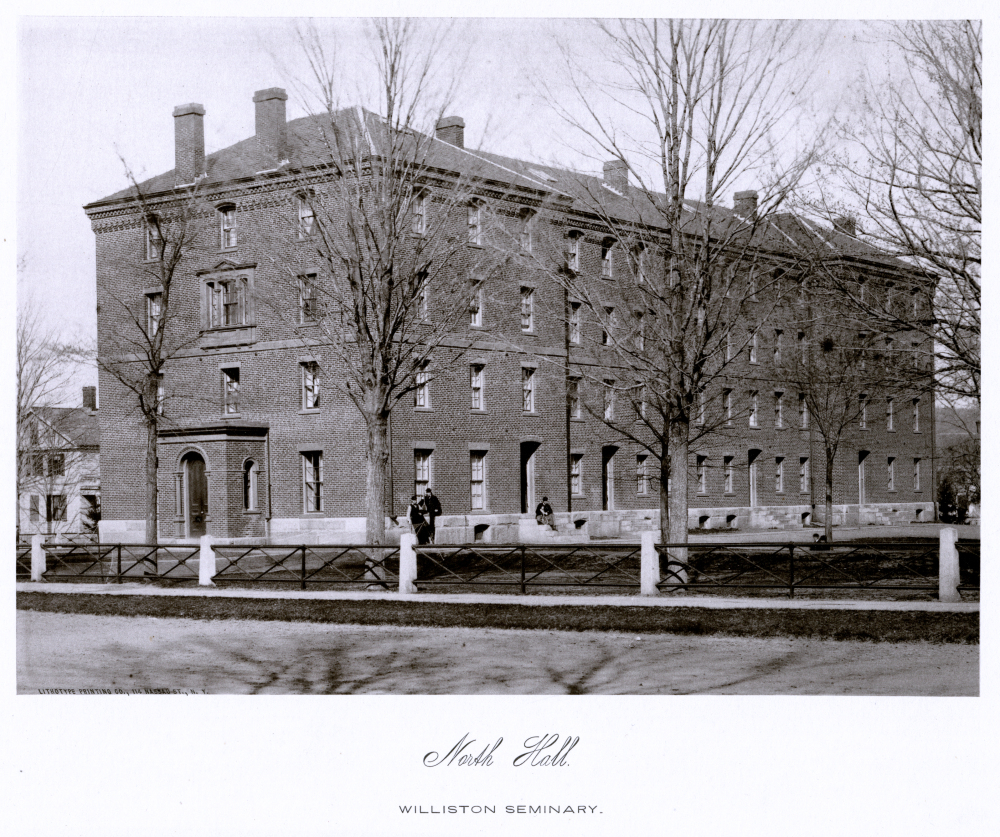 Opened in 1867, North Hall contained student and faculty residences and two recitation rooms. It stood on the current site of the Easthampton Savings Bank; modern Campus Lane now runs to the right of the building.
Opened in 1867, North Hall contained student and faculty residences and two recitation rooms. It stood on the current site of the Easthampton Savings Bank; modern Campus Lane now runs to the right of the building.
No. 7: The Gymnasium
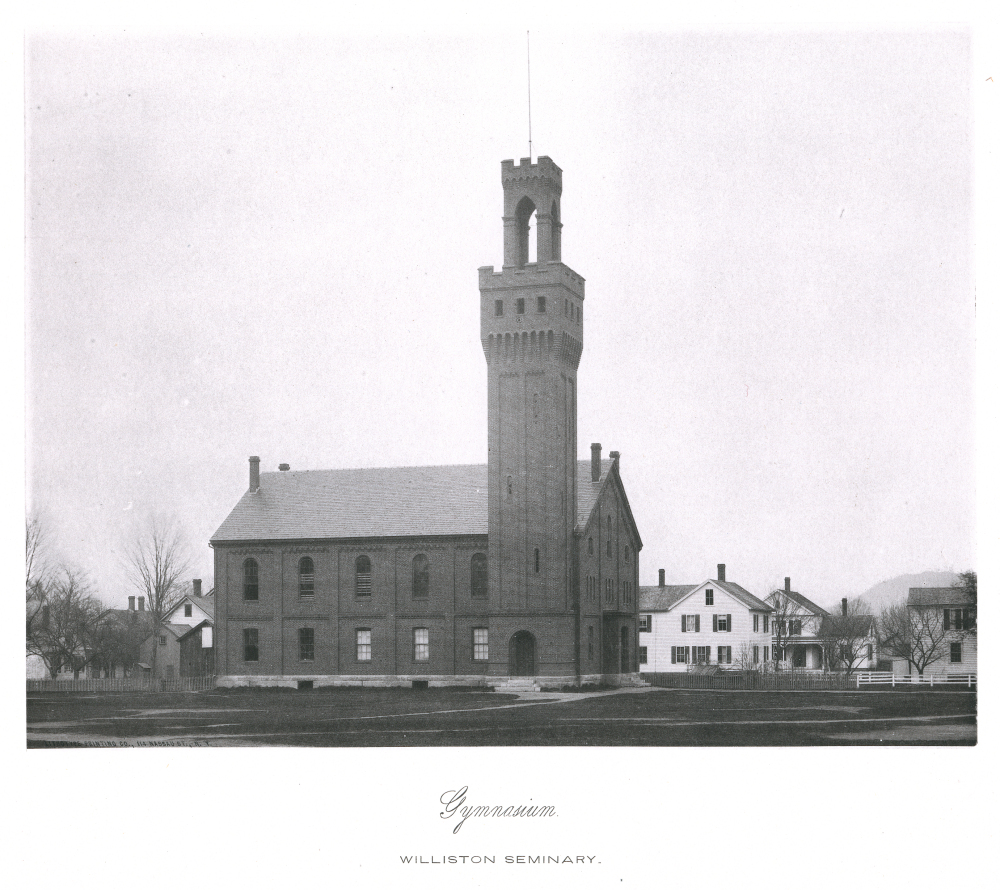 The first free-standing secondary school athletic facility in North America, modeled on structures at Harvard and Amherst, the Gymnasium was built in 1863-64. It was located on what is now the back of Big E’s parking lot, on High Street. Some of the High Street structures in the background remain today.
The first free-standing secondary school athletic facility in North America, modeled on structures at Harvard and Amherst, the Gymnasium was built in 1863-64. It was located on what is now the back of Big E’s parking lot, on High Street. Some of the High Street structures in the background remain today.
No. 8: Interior of the Gymnasium
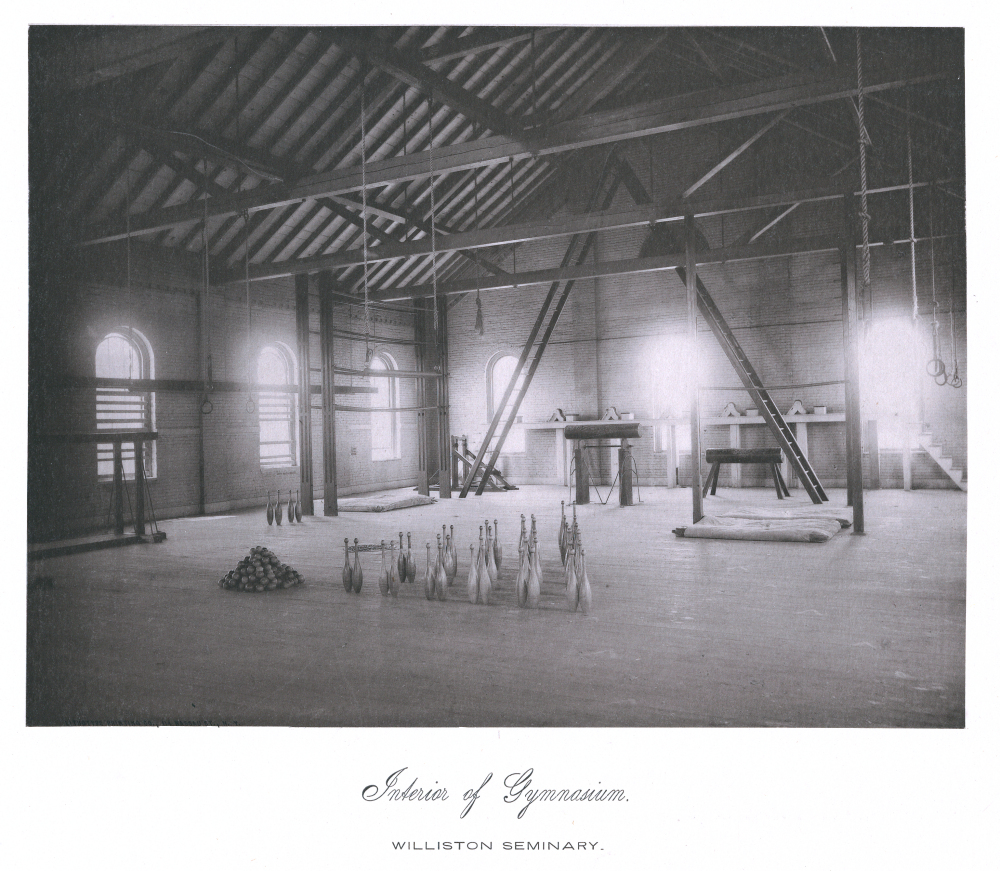 In 1863 basketball had not yet been invented; that would come in 1891, and would reach Williston in 1898. (See “A Brief History of Williston Northampton Basketball.”) The second floor of the Old Gym was devoted to gymnastics, Indian club exercise, and sometimes military drill. What appears to be bowling equipment is actually a collection of Indian clubs and a stack of medicine balls. There was, however, a bowling alley on the ground floor.
In 1863 basketball had not yet been invented; that would come in 1891, and would reach Williston in 1898. (See “A Brief History of Williston Northampton Basketball.”) The second floor of the Old Gym was devoted to gymnastics, Indian club exercise, and sometimes military drill. What appears to be bowling equipment is actually a collection of Indian clubs and a stack of medicine balls. There was, however, a bowling alley on the ground floor.
No. 9: Interior of Chapel
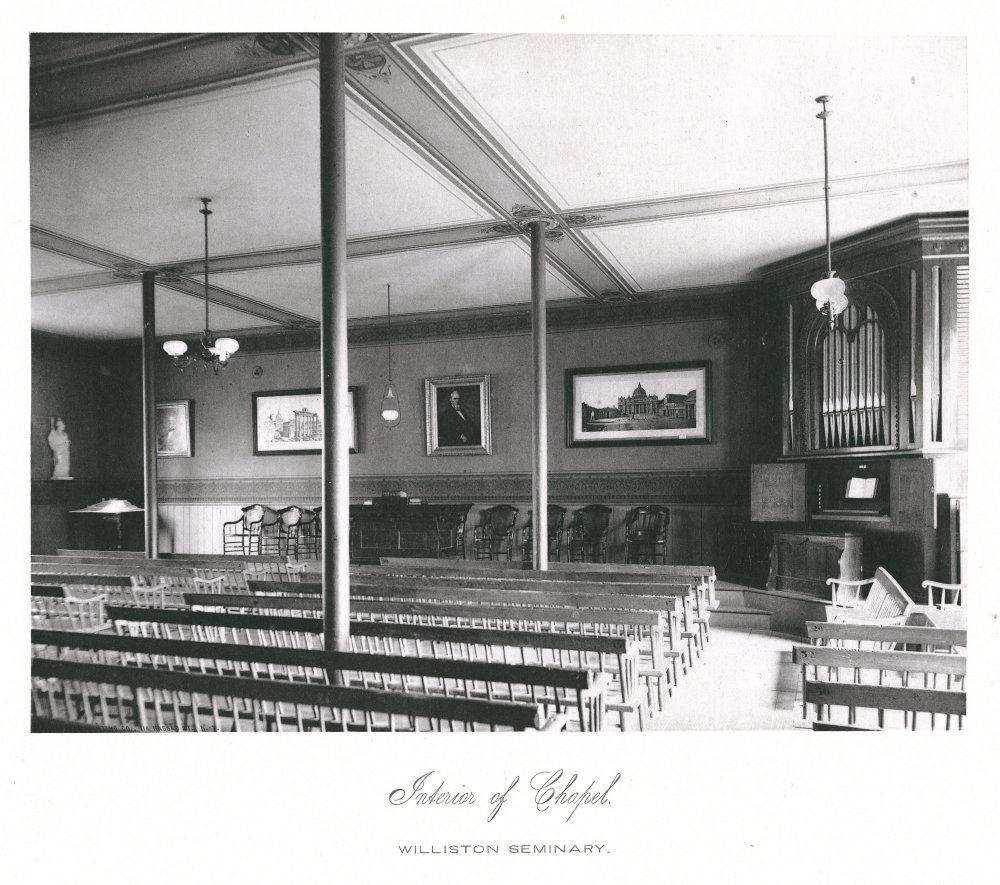 The school chapel was located in South Hall (See no. 4).
The school chapel was located in South Hall (See no. 4).
No. 10: Interior of Adelphi Hall
 Adelphi was one of Williston Seminary’s two rival debating societies. Each held public debates, which drew large audiences from the community as well as the campus, maintained their own libraries, and published literary magazines. Adelphi’s room was located in Middle Hall (see No. 5).
Adelphi was one of Williston Seminary’s two rival debating societies. Each held public debates, which drew large audiences from the community as well as the campus, maintained their own libraries, and published literary magazines. Adelphi’s room was located in Middle Hall (see No. 5).
No. 11: Student’s Study and Bedroom, North Hall
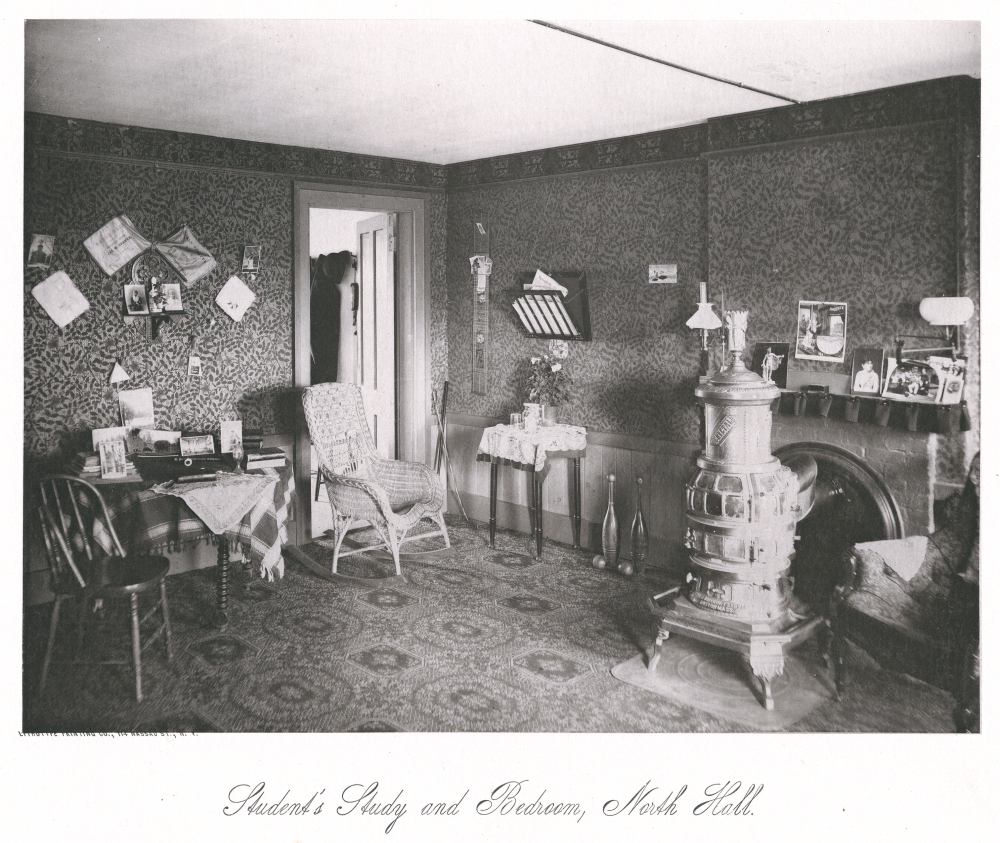 While the room was probably cleaned up for the photograph, the residents cannot have accomplished much studying on that cluttered table. North Hall was comparatively upscale when it was built, with gas lighting and indoor plumbing. Students were, however, expected to provide their own coal for the stoves. (See “An 1880s Williston Scrapbook.”)
While the room was probably cleaned up for the photograph, the residents cannot have accomplished much studying on that cluttered table. North Hall was comparatively upscale when it was built, with gas lighting and indoor plumbing. Students were, however, expected to provide their own coal for the stoves. (See “An 1880s Williston Scrapbook.”)
No. 12: Astronomical Observatory
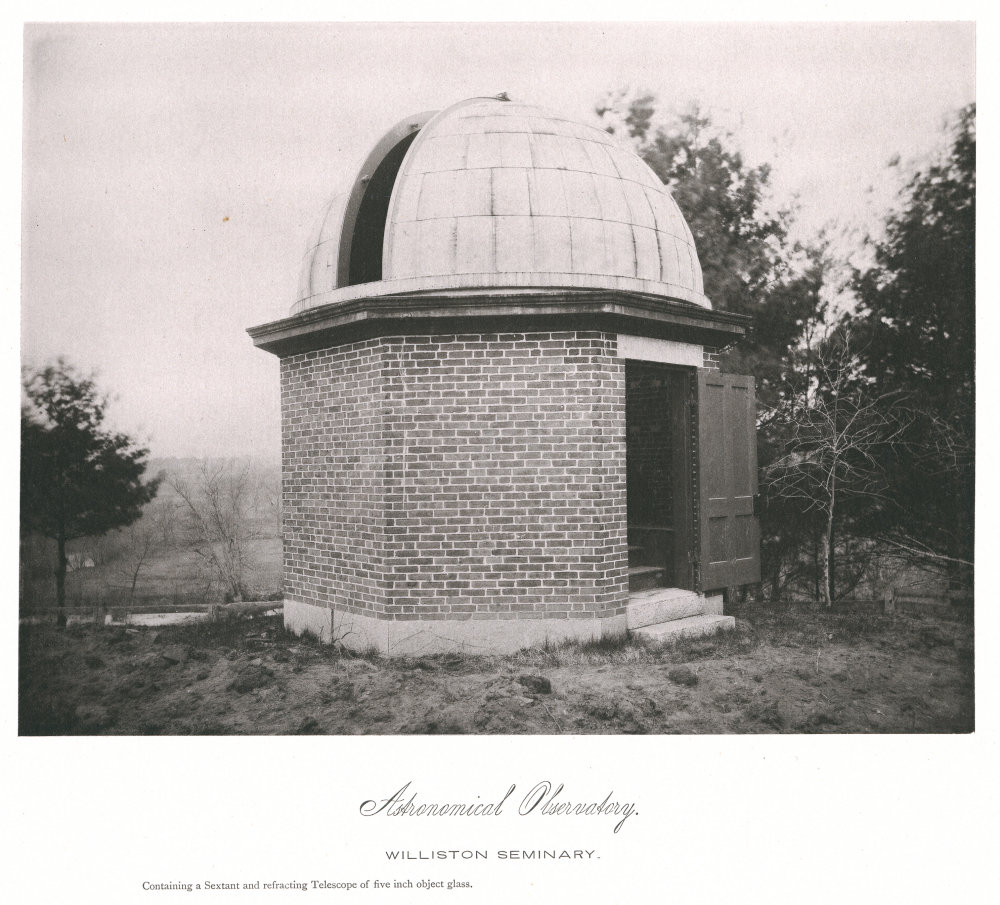 In the 1870s, Williston Seminary obtained a good telescope, which was housed in this building on a bluff overlooking the Manhan, behind present-day Sawyer House at 183 Main Street. The telescope was sold during the financial crises late in the 19th century, but the building remained. The late Roma Donais, who came to Easthampton in the 1930s, recalled that it was used as a bicycle shed.
In the 1870s, Williston Seminary obtained a good telescope, which was housed in this building on a bluff overlooking the Manhan, behind present-day Sawyer House at 183 Main Street. The telescope was sold during the financial crises late in the 19th century, but the building remained. The late Roma Donais, who came to Easthampton in the 1930s, recalled that it was used as a bicycle shed.
No. 13: Seminary Boarding House, and View on Union Street, Looking South
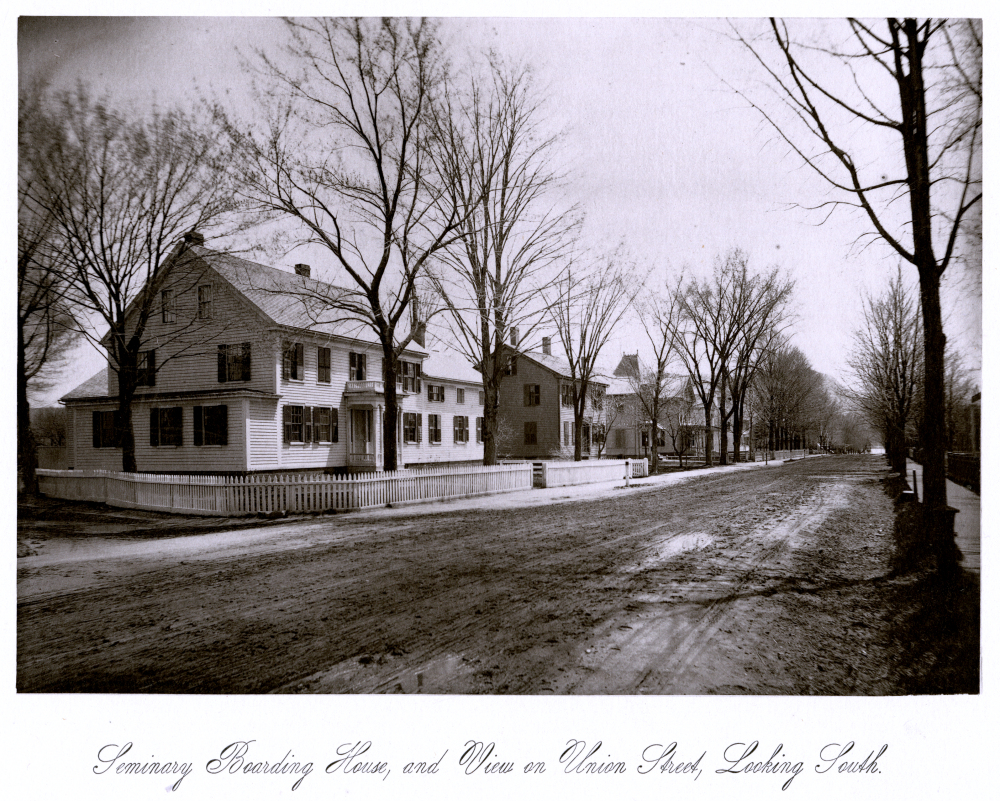 This image is mis-captioned; we are looking east, not south, on Union Street, toward Mt. Tom, clearly visible in the background. This is the intersection of Union and High Streets; the old campus was to the left of the photograph. The 1930s-era Easthampton Post Office, now the Senior Center, is on the site of the Boarding House.
This image is mis-captioned; we are looking east, not south, on Union Street, toward Mt. Tom, clearly visible in the background. This is the intersection of Union and High Streets; the old campus was to the left of the photograph. The 1930s-era Easthampton Post Office, now the Senior Center, is on the site of the Boarding House.
No. 14: Payson Church and View on Main Street, Looking South
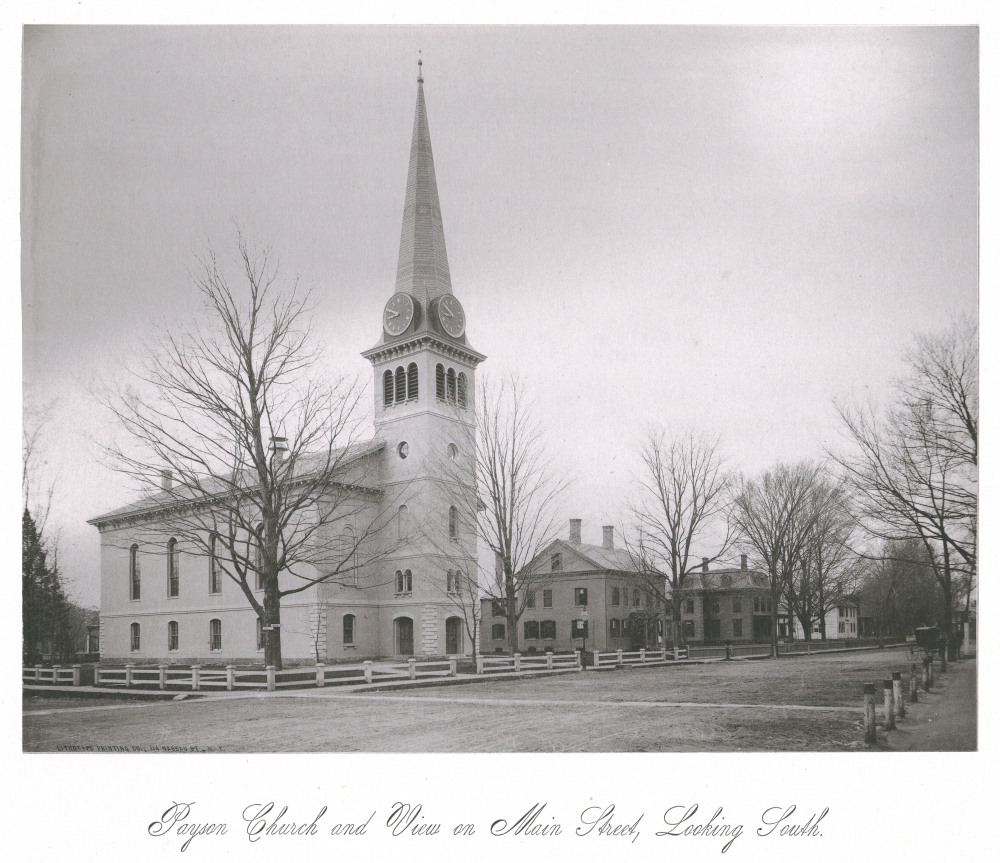 This is the intersection of Main and Union Streets. We see the Payson Church (1852-62) and parsonage, and beyond it, what would become the rectory of St. Philips Episcopal Church (1901). The latter structure was dismantled and rebuilt in Hatfield, Mass. some years ago. (Compare with no. 2, and see “The Congregational Church in Easthampton History.”)
This is the intersection of Main and Union Streets. We see the Payson Church (1852-62) and parsonage, and beyond it, what would become the rectory of St. Philips Episcopal Church (1901). The latter structure was dismantled and rebuilt in Hatfield, Mass. some years ago. (Compare with no. 2, and see “The Congregational Church in Easthampton History.”)
No. 15: Mansion House
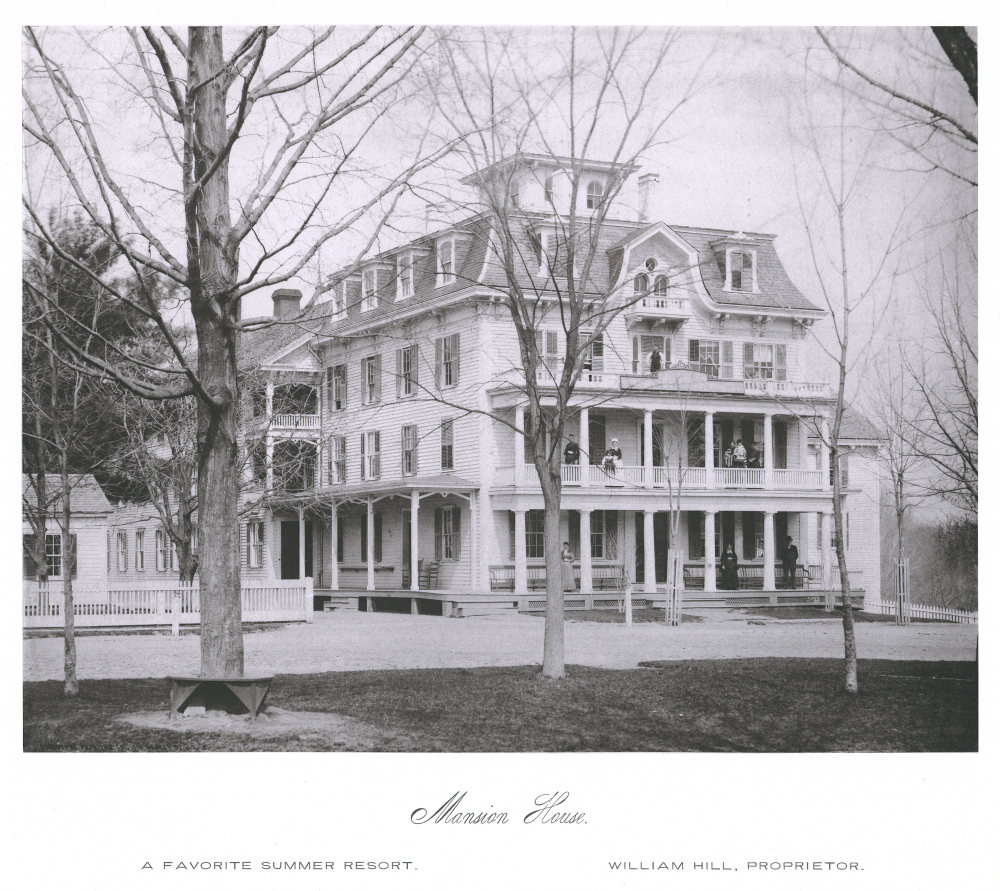 Hill’s Mansion House, erected in 1841-42, was Easthampton’s grand hotel. It stood at the corner of Main and Northampton Streets, where the Florence Savings Bank branch stands today. In the mid-19th century, more affluent Seminary students took rooms and meals there. Later in the century, as Easthampton lost its appeal as a vacation destination, the building suffered some decline. In 1916 it was purchased by Williston Seminary, and renamed Payson Hall. As the three brick buildings across the common were becoming increasingly cramped and obsolete, Payson Hall was used as a dormitory and dining hall, and was the home of the Williston Junior School until 1928. After Williston sold the building in 1951, it became the home of what we will gently term “increasingly affordable” apartments, until it was condemned and torn down in 1969.
Hill’s Mansion House, erected in 1841-42, was Easthampton’s grand hotel. It stood at the corner of Main and Northampton Streets, where the Florence Savings Bank branch stands today. In the mid-19th century, more affluent Seminary students took rooms and meals there. Later in the century, as Easthampton lost its appeal as a vacation destination, the building suffered some decline. In 1916 it was purchased by Williston Seminary, and renamed Payson Hall. As the three brick buildings across the common were becoming increasingly cramped and obsolete, Payson Hall was used as a dormitory and dining hall, and was the home of the Williston Junior School until 1928. After Williston sold the building in 1951, it became the home of what we will gently term “increasingly affordable” apartments, until it was condemned and torn down in 1969.
No. 16: Residence of the late Hon. Samuel Williston
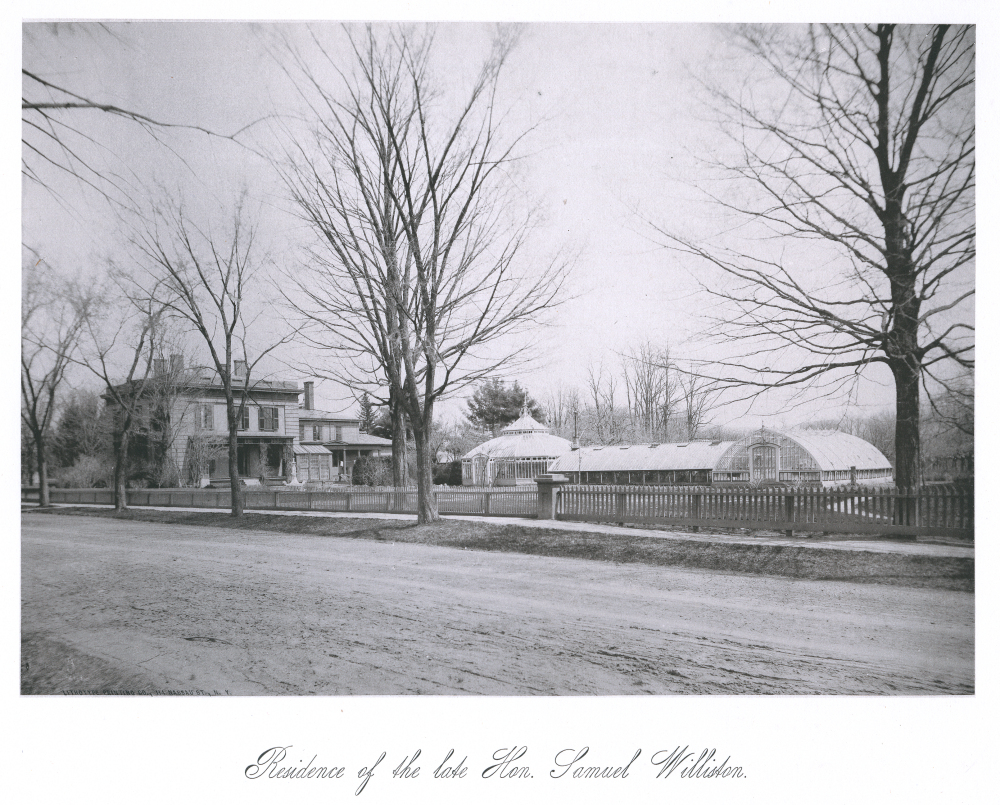 Now known as the Williston Homestead, this 1843 structure came from a book of plans by Savannah, Georgia architect William Fenno Pratt. The designs were shared among many Hampshire County textile barons, who had business interest in the South, where their cotton was grown. Two other structures on this plan are known. The house stands on the northwest corner of the Williston Northampton campus, at the intersection of Park Street and Payson Avenue, and hosts Williston Northampton’s Admission, Advancement, and Communications offices.
Now known as the Williston Homestead, this 1843 structure came from a book of plans by Savannah, Georgia architect William Fenno Pratt. The designs were shared among many Hampshire County textile barons, who had business interest in the South, where their cotton was grown. Two other structures on this plan are known. The house stands on the northwest corner of the Williston Northampton campus, at the intersection of Park Street and Payson Avenue, and hosts Williston Northampton’s Admission, Advancement, and Communications offices.
Samuel Williston died in 1874, Emily Williston in 1885; thus this image helps us date the photographs to sometime prior to 1885. Shortly after Emily’s death, the house became the residence of the Williston Principals. The greenhouses were dismantled and sold.
No. 17: Residence of the late Hon. E. H. Sawyer
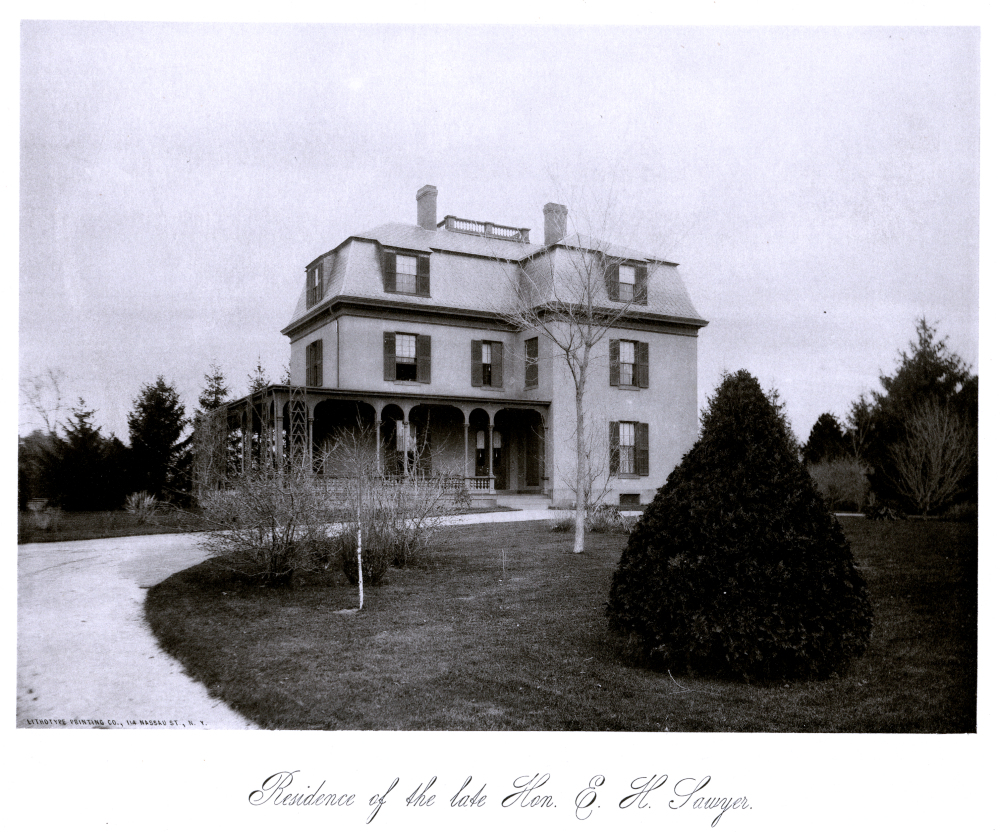 Edmund H. Sawyer (1812-1879), protégé of Samuel Williston, was a major player in the Easthampton textile industries. His grand house, built in 1863, stood on Park Street where Williston Northampton’s John Wright Dormitory now stands. It was considered the centerpiece of “Sawyer Park,” a planned enclave of great houses. Sawyer died relatively young; his widow remained in the house until 1898, after which it may have been unoccupied. It was razed in the early 1930s.
Edmund H. Sawyer (1812-1879), protégé of Samuel Williston, was a major player in the Easthampton textile industries. His grand house, built in 1863, stood on Park Street where Williston Northampton’s John Wright Dormitory now stands. It was considered the centerpiece of “Sawyer Park,” a planned enclave of great houses. Sawyer died relatively young; his widow remained in the house until 1898, after which it may have been unoccupied. It was razed in the early 1930s.
No. 18: View on Park Street, Looking North
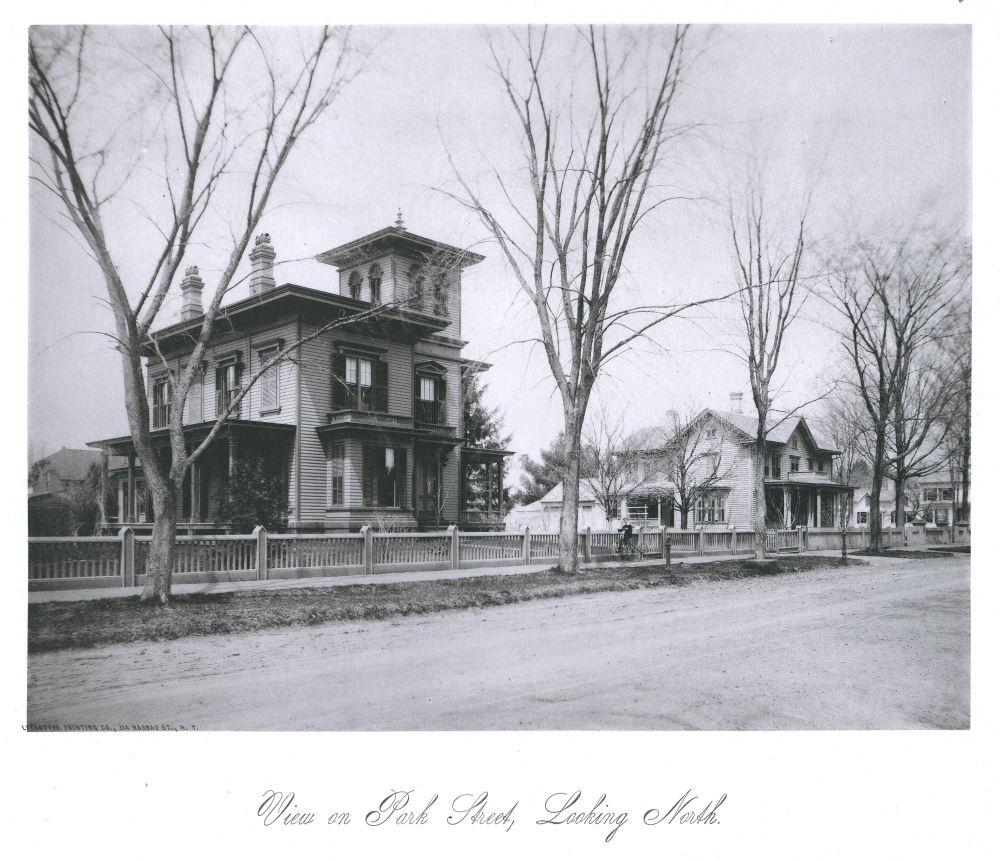 This house, E. H. Sawyer’s neighbor to the north, is believed to have been built by another Easthampton textile magnate, Granville Leonard, who also used plans by William Fenno Pratt (see no. 16). An identical building, now demolished, stood on Pomeroy Terrace in Northampton. The house, the present-day residence of the Williston Northampton Head of School, now looks very different, having been extensively remodeled by resident Franklin Richmond in the 1920s. Renovations included removal of the tower and the addition of a kitchen wing at the rear of the house. Beyond it is the former Easthampton parsonage, residence of the Rev. Payson Williston and birthplace of Samuel Williston. It is now a Williston Northampton faculty residence. Careful observers will note the kid on a tricycle at the center. The Williston campus is directly across the street.
This house, E. H. Sawyer’s neighbor to the north, is believed to have been built by another Easthampton textile magnate, Granville Leonard, who also used plans by William Fenno Pratt (see no. 16). An identical building, now demolished, stood on Pomeroy Terrace in Northampton. The house, the present-day residence of the Williston Northampton Head of School, now looks very different, having been extensively remodeled by resident Franklin Richmond in the 1920s. Renovations included removal of the tower and the addition of a kitchen wing at the rear of the house. Beyond it is the former Easthampton parsonage, residence of the Rev. Payson Williston and birthplace of Samuel Williston. It is now a Williston Northampton faculty residence. Careful observers will note the kid on a tricycle at the center. The Williston campus is directly across the street.
No. 19: View on Main Street, Looking North
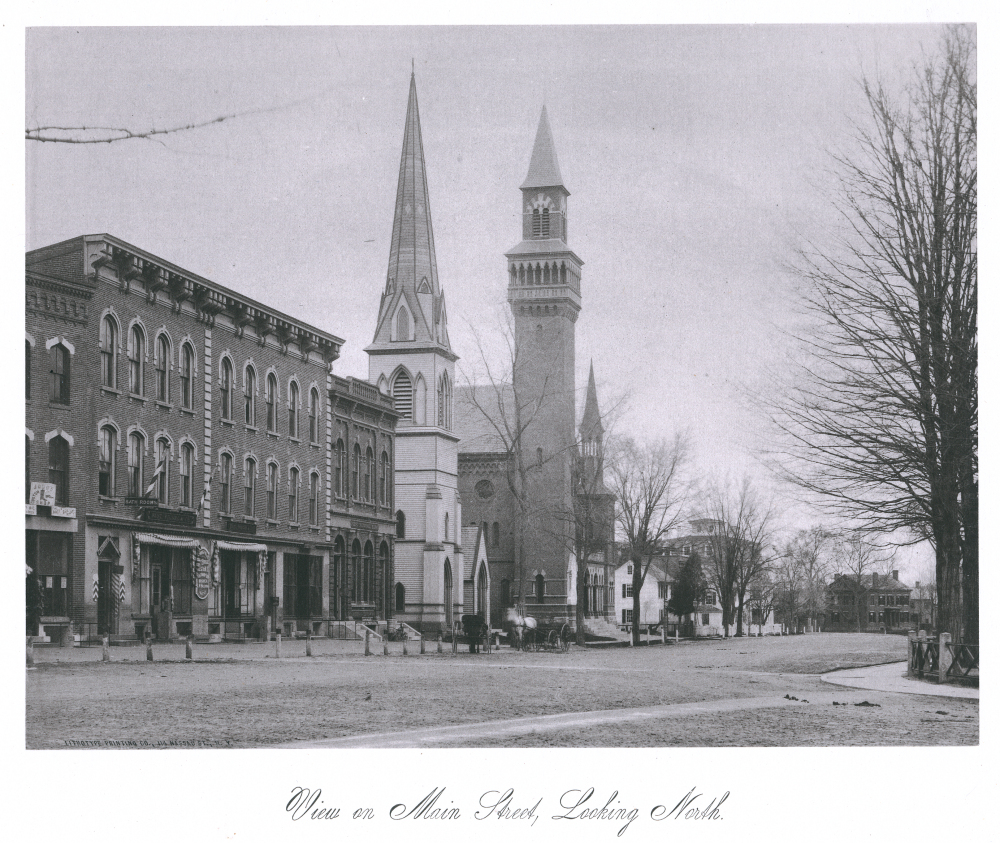 We are back to the center of town, looking at Shop Row and the Town Hall from the corner of Main and Union Streets. All of these mid-19th century buildings still stand, except the church south of the Town Hall (see no. 23).
We are back to the center of town, looking at Shop Row and the Town Hall from the corner of Main and Union Streets. All of these mid-19th century buildings still stand, except the church south of the Town Hall (see no. 23).
No. 20: Residence of Hon. Horatio G. Knight
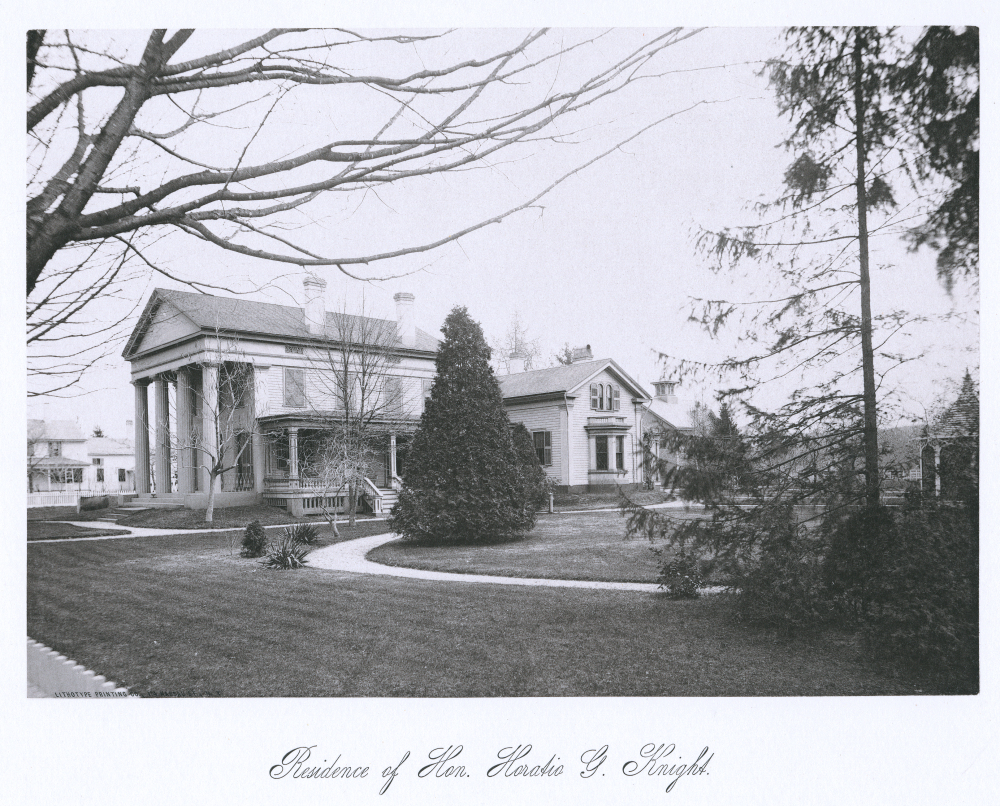 Samuel Williston’s business partner Horatio Knight (1817-1895) built this Greek Revival house in 1841 – other sources say 1835, but that seems too early. The first of Easthampton’s grand mansions, it may have inspired a friendly competition. In 1841 Knight’s senior partner Samuel, still living with his parents in the parsonage, almost immediately started work on the Homestead. The Knight Mansion still stands, now a private residence.
Samuel Williston’s business partner Horatio Knight (1817-1895) built this Greek Revival house in 1841 – other sources say 1835, but that seems too early. The first of Easthampton’s grand mansions, it may have inspired a friendly competition. In 1841 Knight’s senior partner Samuel, still living with his parents in the parsonage, almost immediately started work on the Homestead. The Knight Mansion still stands, now a private residence.
The caption implies that Knight was still living; thus providing evidence that the portfolio was published prior to 1895.
No. 21: Easthampton Public Library, and View on Park Street, Looking South
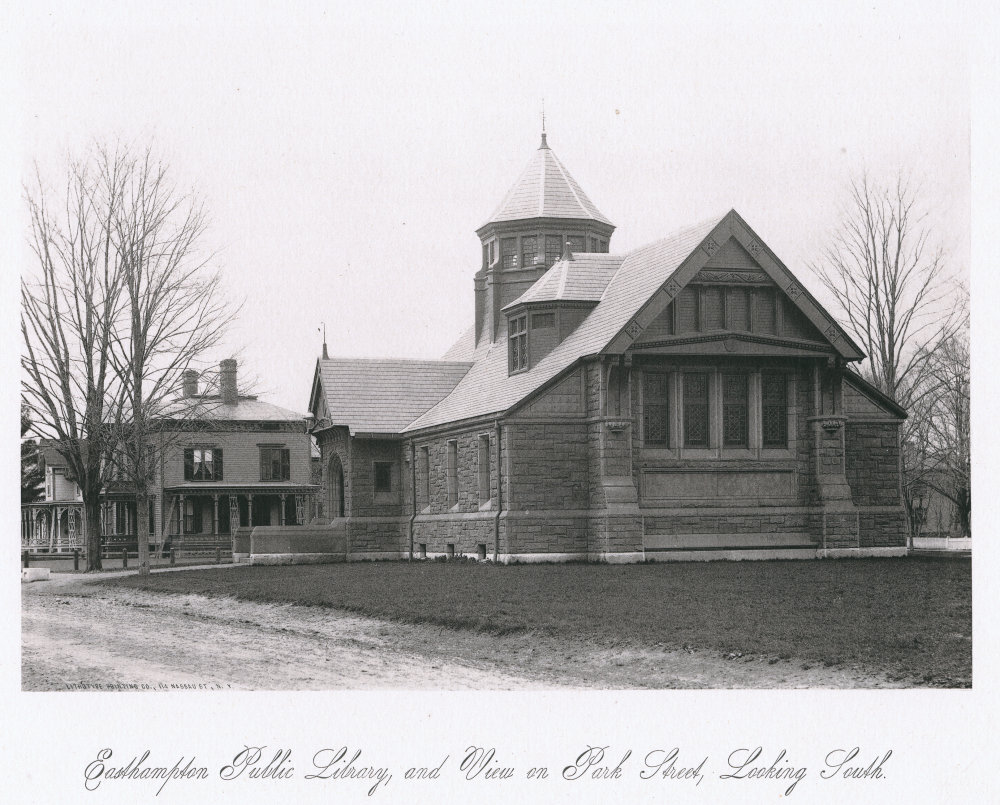 Now the Emily Williston Memorial Library and Museum, the building, built in 1881, looks bran-new in this picture. This also helps us fix an 1880s date for the set of photographs. The house beyond it, for many decades the Mitchell Funeral Home, remains.
Now the Emily Williston Memorial Library and Museum, the building, built in 1881, looks bran-new in this picture. This also helps us fix an 1880s date for the set of photographs. The house beyond it, for many decades the Mitchell Funeral Home, remains.
No. 22: View on Main Street, Looking North
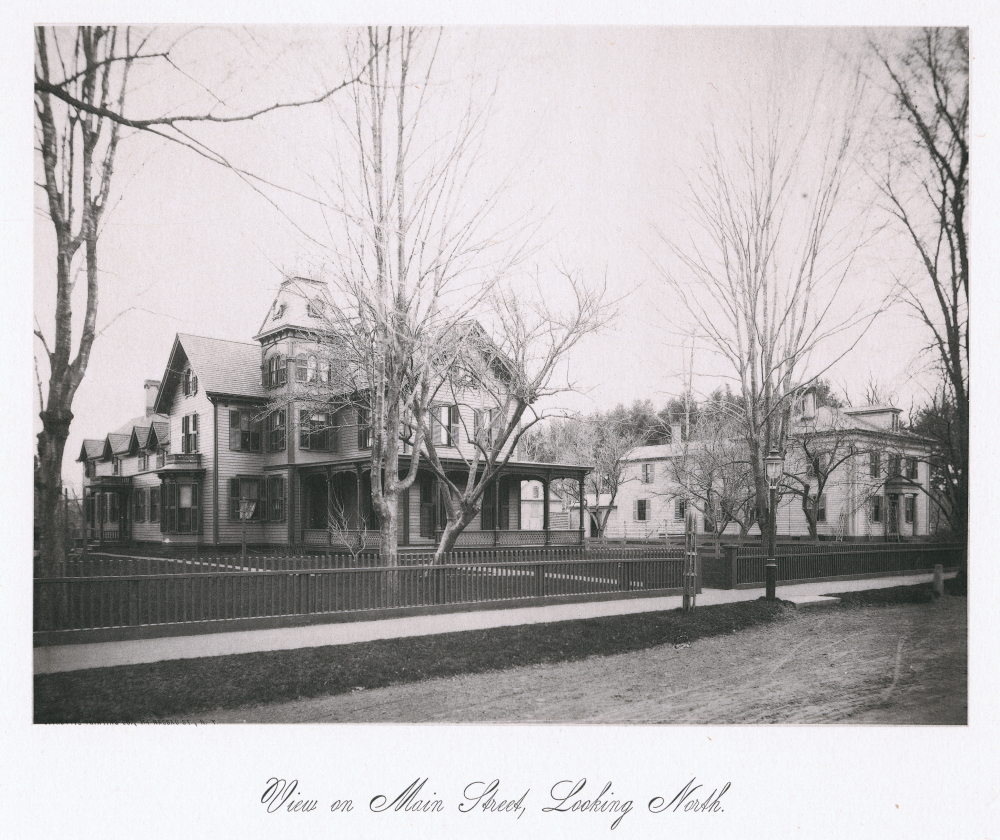 The house in the foreground was built by Samuel Williston’s associate Seth Warner, ca. 1875. The structure at right dates from 1849 or earlier, and was the home of Williston Seminary Principals from that year until 1886, when the Homestead became the official residence. In 1928 both buildings, named Williston Cottage and Sawyer House, became residence halls for the Williston Junior School, and later, Williston Academy dormitories. Williston Cottage, rechristened Conant House in 1971, remains a faculty residence and overflow dormitory, while Sawyer House is the home of the Williston Northampton Archives.
The house in the foreground was built by Samuel Williston’s associate Seth Warner, ca. 1875. The structure at right dates from 1849 or earlier, and was the home of Williston Seminary Principals from that year until 1886, when the Homestead became the official residence. In 1928 both buildings, named Williston Cottage and Sawyer House, became residence halls for the Williston Junior School, and later, Williston Academy dormitories. Williston Cottage, rechristened Conant House in 1971, remains a faculty residence and overflow dormitory, while Sawyer House is the home of the Williston Northampton Archives.
No. 23: Methodist Church and Town Hall
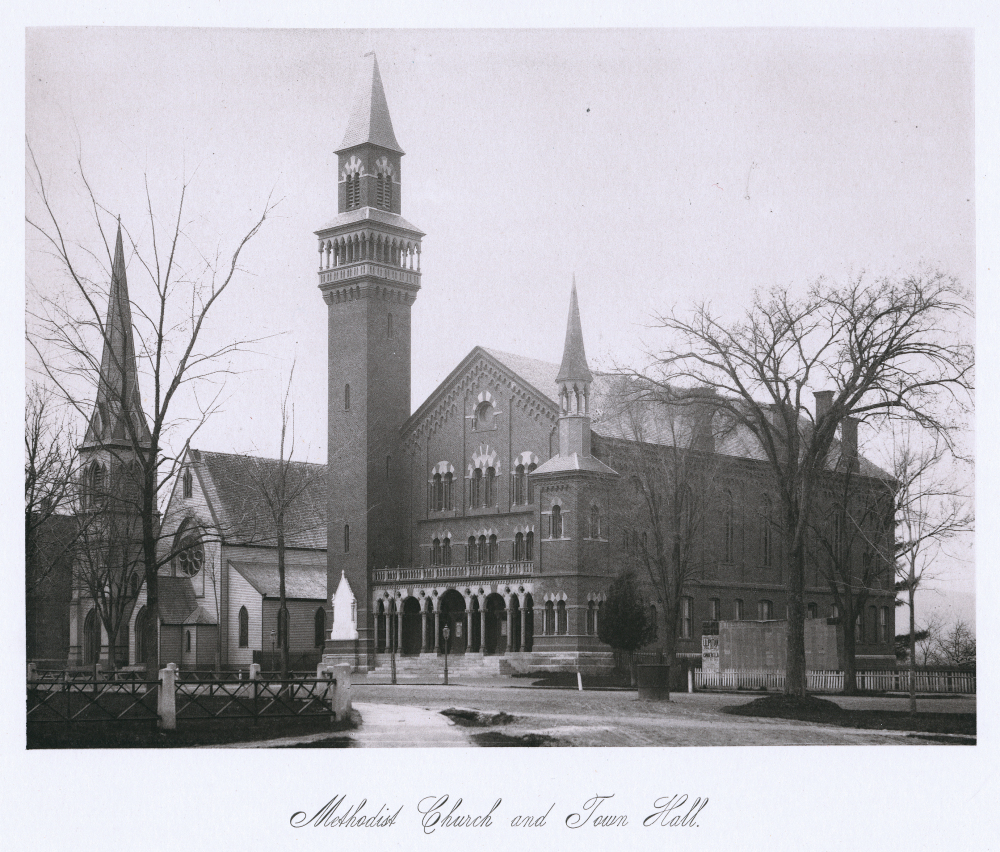 The Easthampton Town Hall, at the top of Main Street, was built in 1869 by Samuel Williston as a Civil War memorial, and is presently undergoing an ambitious transformation to CitySpace, an arts center. The old Methodist Church, to its left, was built in 1862 and succumbed to fire in 1892. It was replaced by the current brick structure, which was the home of Providence Methodist Church until that congregation merged with its Northampton brethren in 1977. Today, it hosts a child care center.
The Easthampton Town Hall, at the top of Main Street, was built in 1869 by Samuel Williston as a Civil War memorial, and is presently undergoing an ambitious transformation to CitySpace, an arts center. The old Methodist Church, to its left, was built in 1862 and succumbed to fire in 1892. It was replaced by the current brick structure, which was the home of Providence Methodist Church until that congregation merged with its Northampton brethren in 1977. Today, it hosts a child care center.
No. 24: View Below the Dam on the Manhan River
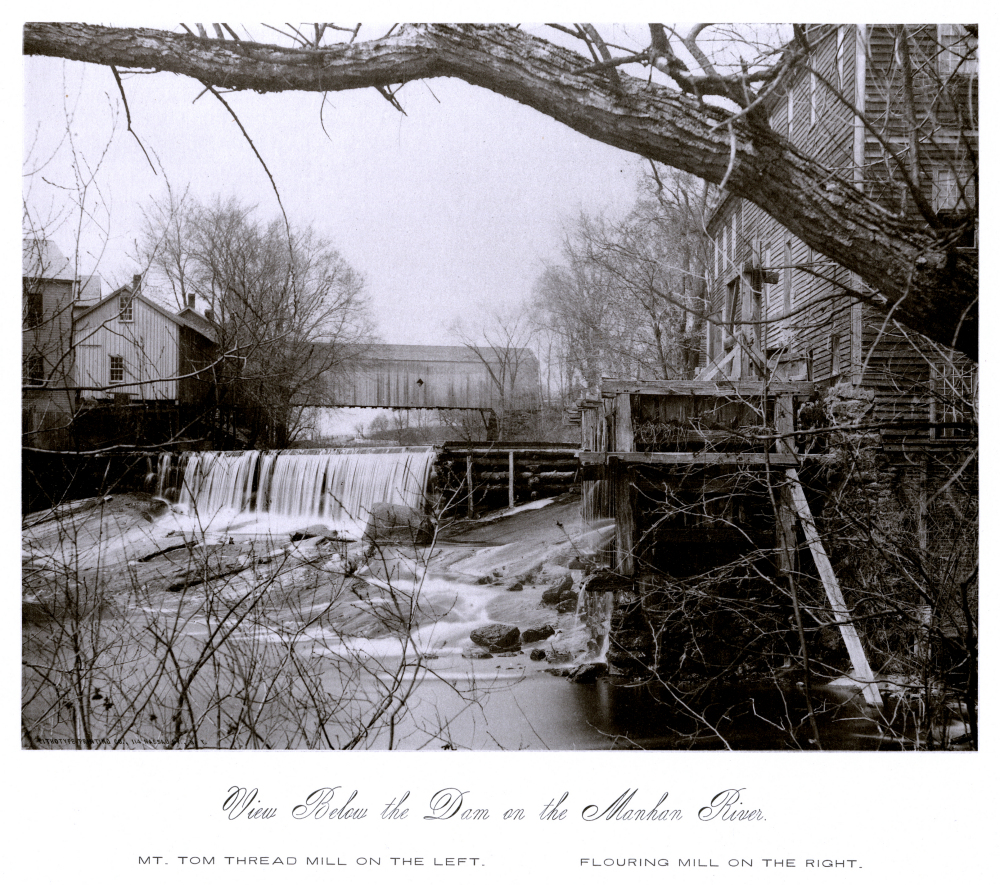 We are below the spillway of the Manhan Dam. The flour mill, at right, first established in the 1790s, gave its name to present-day Mill Street. This is a rare view of the old covered bridge on Northampton Street.
We are below the spillway of the Manhan Dam. The flour mill, at right, first established in the 1790s, gave its name to present-day Mill Street. This is a rare view of the old covered bridge on Northampton Street.
No. 25: View on the Manhan River
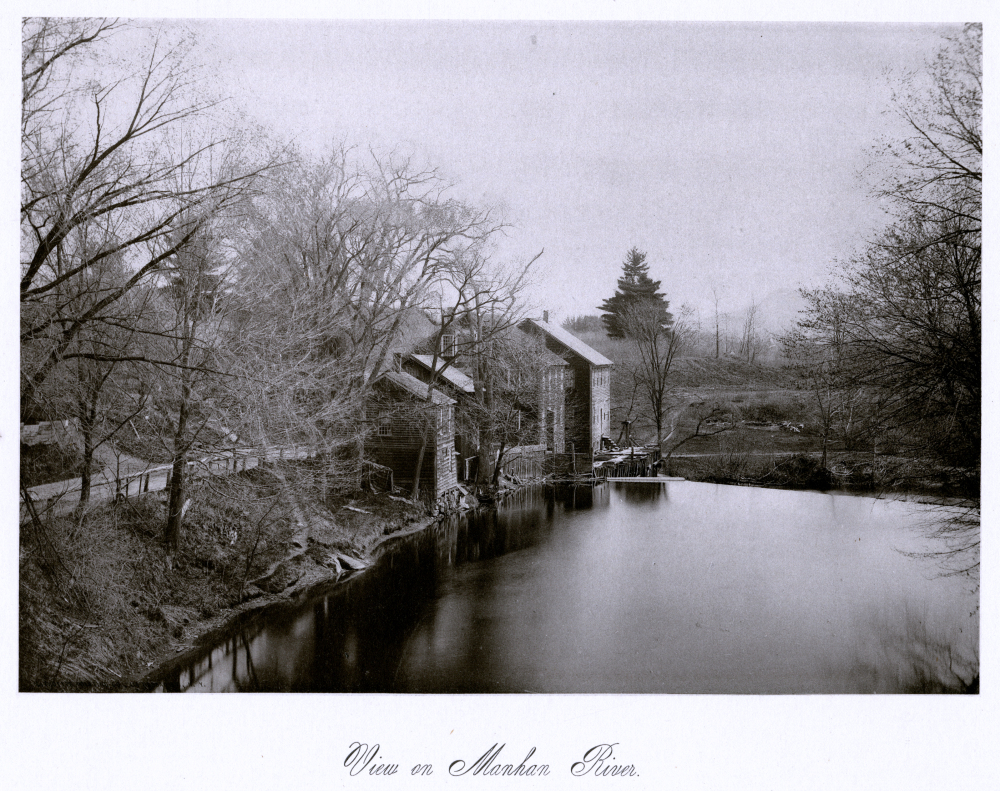 The view is from the covered bridge, looking at the flour mill.
The view is from the covered bridge, looking at the flour mill.
No. 26: View on Nashawannuck Lake and Mt. Tom in the Distance
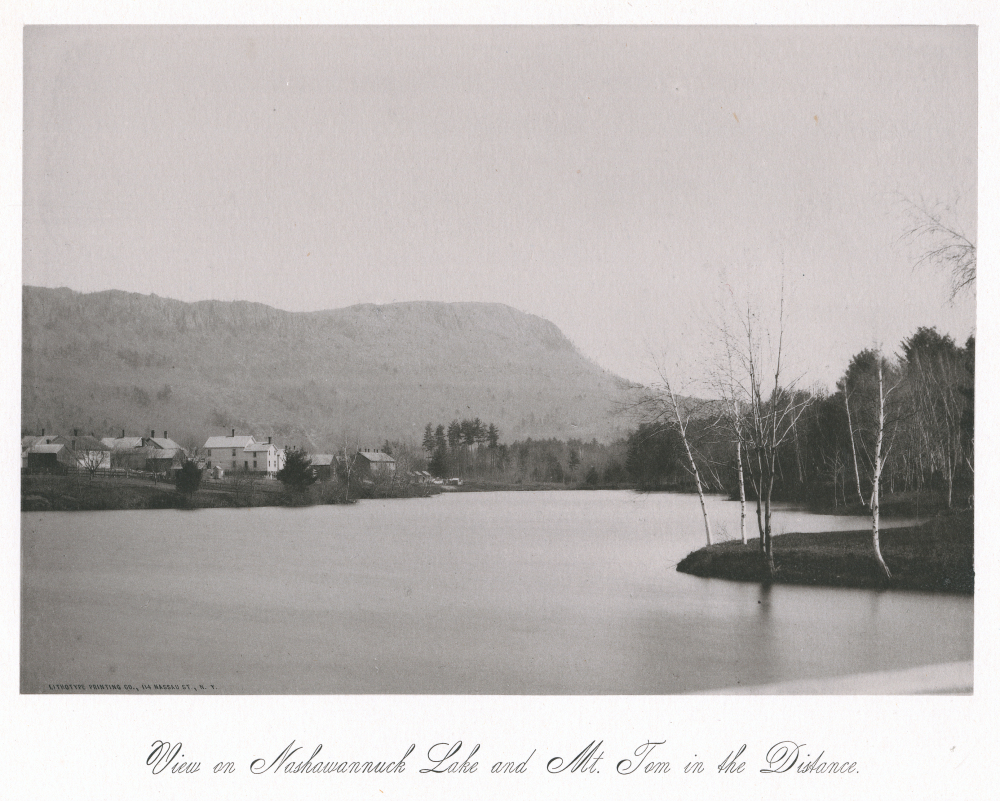 Here the vantage point is from a causeway, now Williston Avenue, crossing the pond. Brookside, at the time being developed as a cemetery, is to the right.
Here the vantage point is from a causeway, now Williston Avenue, crossing the pond. Brookside, at the time being developed as a cemetery, is to the right.
No. 27: Williston Mills
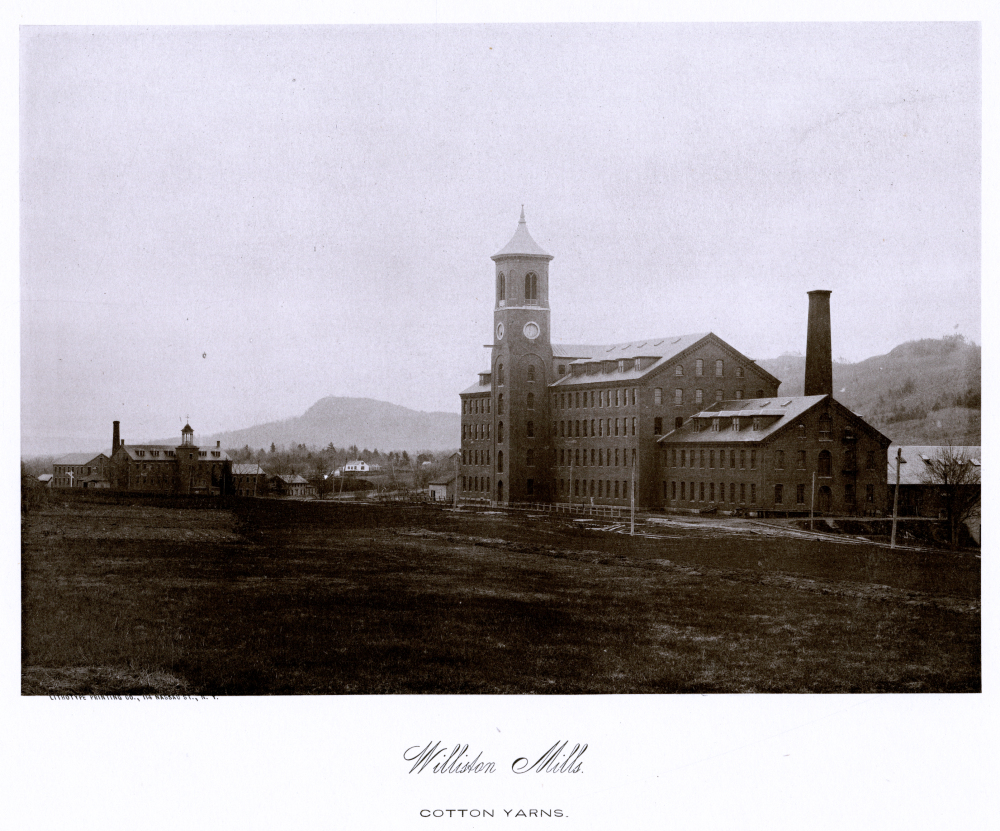 This photograph initially made no sense as part of a set of Easthampton views – the profile of Mt. Tom is very like how it appears from West Springfield. All becomes clear when one realizes that the publisher printed the photograph backwards. The corrected image is below. The factory, built in 1859, stood across Pleasant Street from the present-day Eastworks building, not yet constructed in this photograph. It eventually became part of the West Boylston Co., which left town in 1899. The building was mostly vacant until 1932, when it was demolished.
This photograph initially made no sense as part of a set of Easthampton views – the profile of Mt. Tom is very like how it appears from West Springfield. All becomes clear when one realizes that the publisher printed the photograph backwards. The corrected image is below. The factory, built in 1859, stood across Pleasant Street from the present-day Eastworks building, not yet constructed in this photograph. It eventually became part of the West Boylston Co., which left town in 1899. The building was mostly vacant until 1932, when it was demolished.
No. 28: Williston and Knight Company
Now known simply as “The Button Building” and containing professional office suites, tradition states that structure on Union Street was Easthampton’s first factory. Recent research by Marvin Ward has disproved that. The original button factory, erected in 1847, is now part of the Nashawannuck Mills complex, and is visible in photograph no. 29. The “Button Building” above was built in 1861-62, when the Glendale Company moved its operations to central Easthampton and took over the Nashawannuck complex. Prior to its present incarnation, the Button Building’s longtime tenant was the Landry Furniture Company. One of the workers’ tenements in the background remains today, the home of the Easthampton Diner.
No. 29: Glendale Elastic Fabrics Company
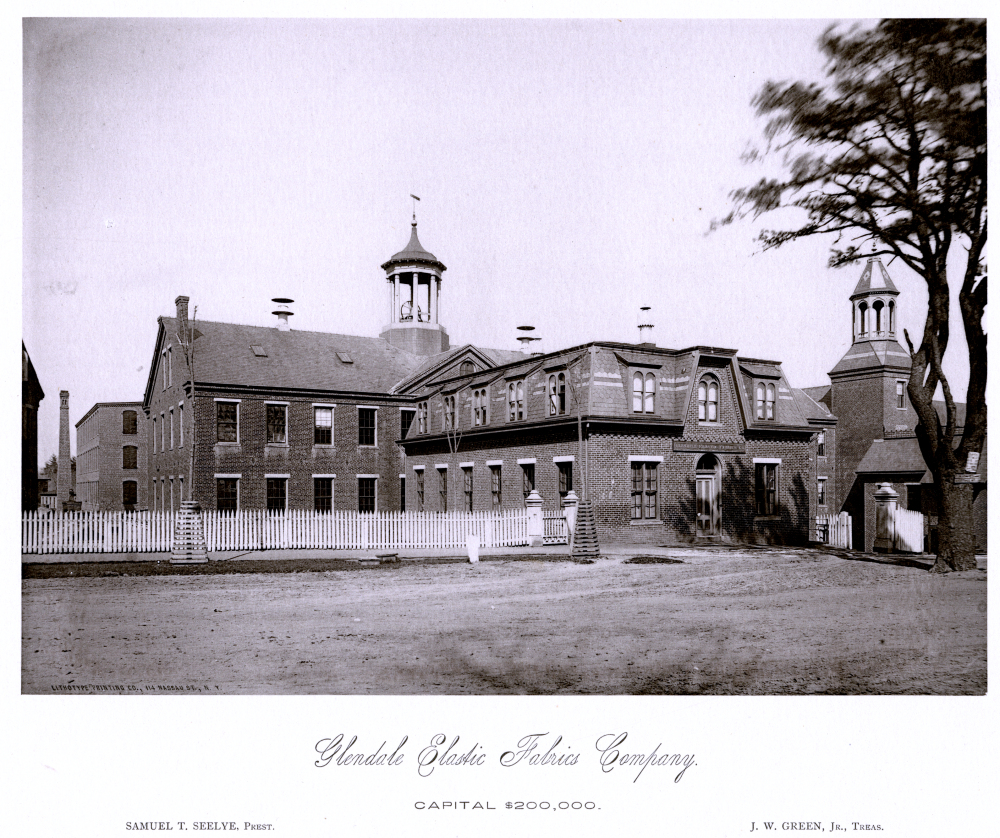 This photograph is potentially confusing, since the original Glendale plant, of which nothing remains, was out on Glendale Street/Loudville Road, on the border of Easthampton and Southampton. This image is clearly just west of the Nashawannuck complex — compare it with the next picture. The building with the cupola, used today by Riverside Industries, is Samuel Williston’s 1847 button factory. (For a rendering, see “Albert Kiesling at Williston.”)
This photograph is potentially confusing, since the original Glendale plant, of which nothing remains, was out on Glendale Street/Loudville Road, on the border of Easthampton and Southampton. This image is clearly just west of the Nashawannuck complex — compare it with the next picture. The building with the cupola, used today by Riverside Industries, is Samuel Williston’s 1847 button factory. (For a rendering, see “Albert Kiesling at Williston.”)
No. 30: Nashawannuck Manufacturing Company
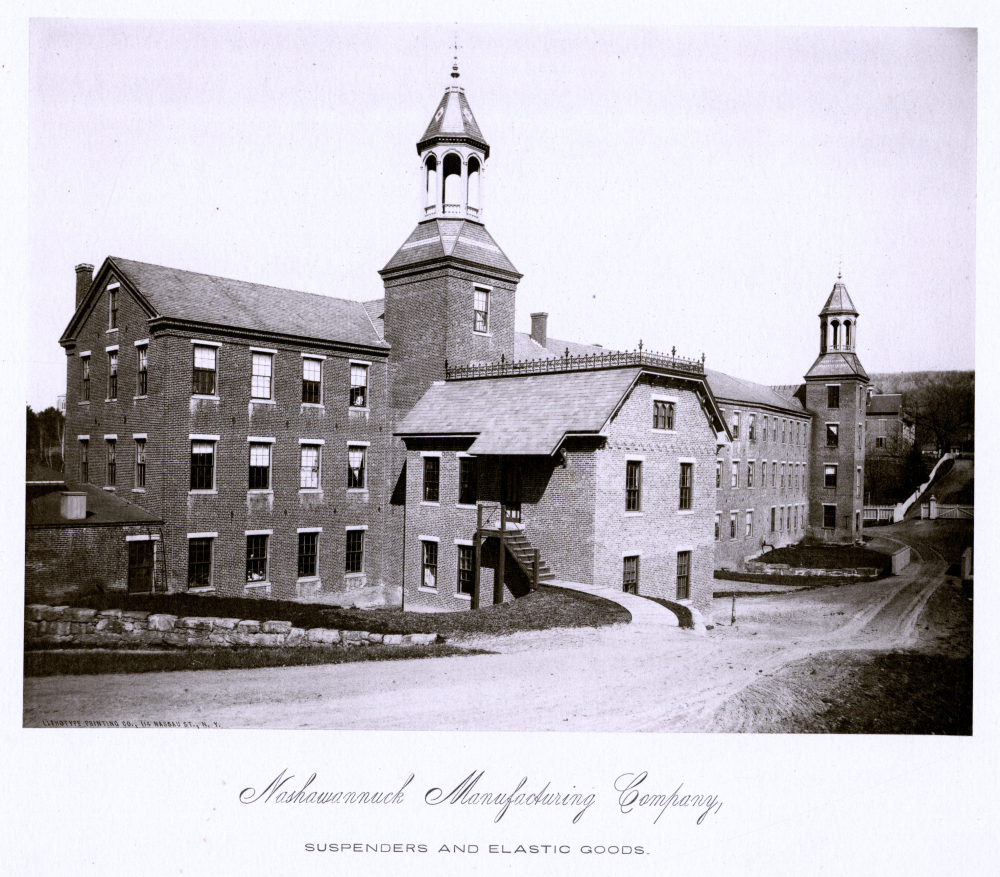 The Nashawannuck mills still stand on Cottage Street, across from Nashawannuck Pond. The complex of factory buildings tripled in size over the next century. The central facade of this structure collapsed during the floods of 1955, but was restored, with improvements to Cottage Street, the dam, and Samuel Williston’s innovative spillway, which directed water underneath the factories and ultimately to the Lower Mill Pond on Pleasant Street.
The Nashawannuck mills still stand on Cottage Street, across from Nashawannuck Pond. The complex of factory buildings tripled in size over the next century. The central facade of this structure collapsed during the floods of 1955, but was restored, with improvements to Cottage Street, the dam, and Samuel Williston’s innovative spillway, which directed water underneath the factories and ultimately to the Lower Mill Pond on Pleasant Street.
No. 31: Easthampton Rubber Thread Company
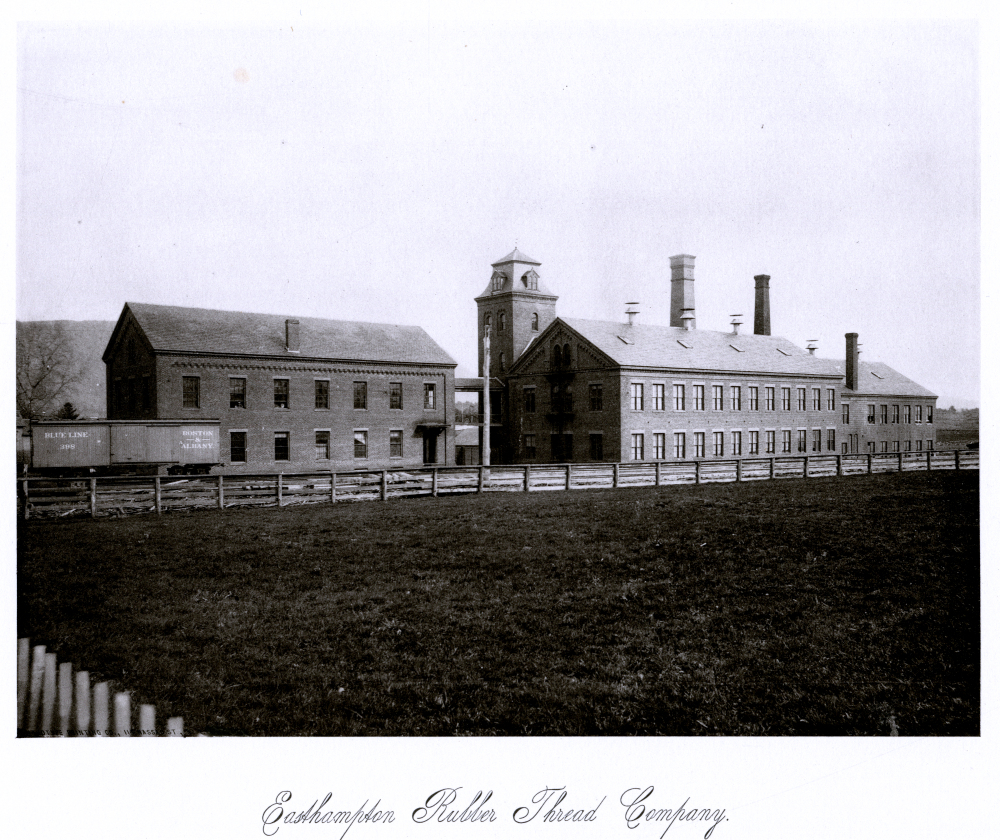 The Rubber Thread mills stood on Payson Avenue, on the site of the present day Easthampton Public Safety Complex. They were razed in the late 1990s to make way for that building, which opened in 1999.
The Rubber Thread mills stood on Payson Avenue, on the site of the present day Easthampton Public Safety Complex. They were razed in the late 1990s to make way for that building, which opened in 1999.
No. 32: Valley Machine Company
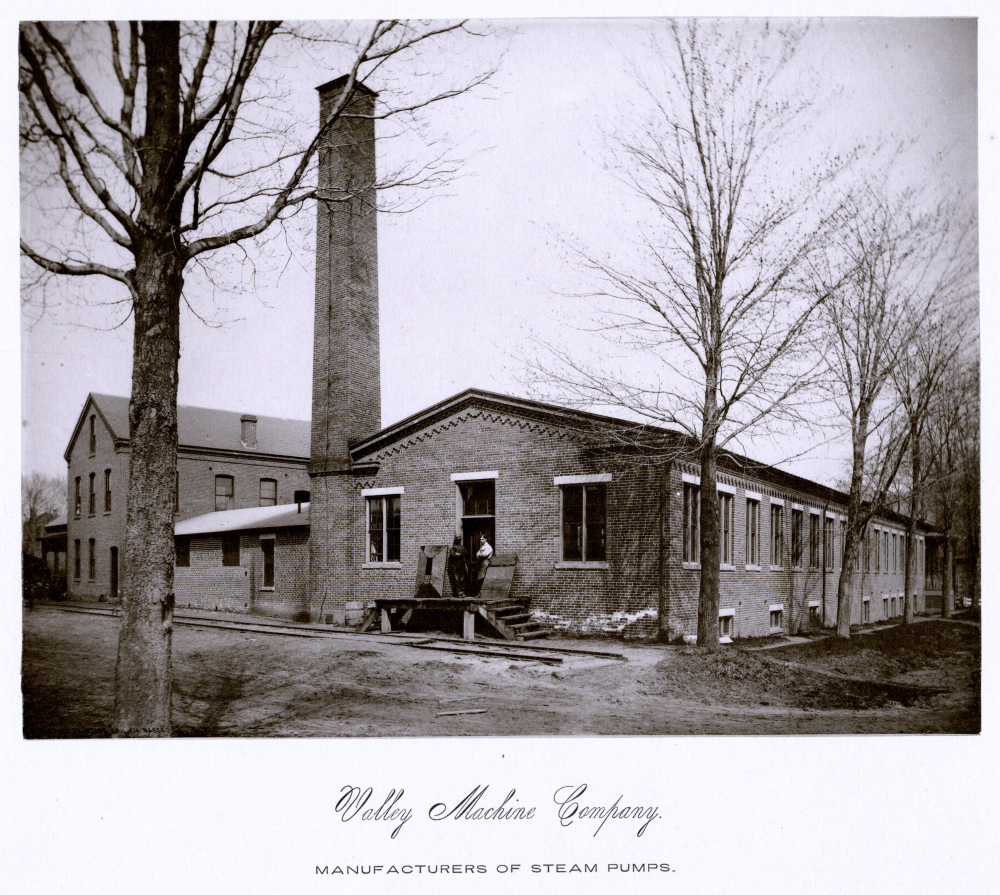 A portion of this building, with an added upper story, still stands on Payson Avenue, opposite the Public Safety Complex. For many years it was home to the Easthampton News Co., a publisher and commercial printer.
A portion of this building, with an added upper story, still stands on Payson Avenue, opposite the Public Safety Complex. For many years it was home to the Easthampton News Co., a publisher and commercial printer.


